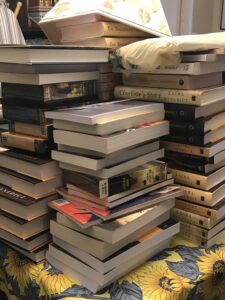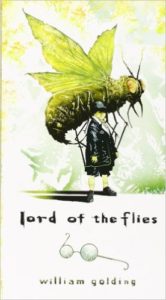by James Scott Bell
@jamesscottbell
 Happy Easter. Happy Passover. Happy Sunday. Whether you worship, play, or simply lounge around, may you feel renewed and refreshed this day.
Happy Easter. Happy Passover. Happy Sunday. Whether you worship, play, or simply lounge around, may you feel renewed and refreshed this day.
We’ll be having a family feed with the grandboys, complete with Easter egg hunt. Which invites the question: What’s the deal with eggs and bunnies? How did those things become symbols of the season?
It’s a fascinating inquiry. In the pre-Christian era, eggs were part of the fertility lore of the Indo-European races. In Persia, eggs were presented at the spring equinox, which represented the start of a new year.
At some point in the Middle Ages, the egg was incorporated into the Christian observance of Easter as a symbol of new birth. Added to it was the practice of coloring the shells. As one tongue-tangled minister put it to his congregation some years ago, “In honor of Easter, Edna Johnson will step forward and lay an egg on the altar.”
What about the Easter bunny? Well, bunnies are certainly fertile. That symbolism goes all the way back to the ancient Egyptians. But that’s probably not why they’re associated with Easter.
It seems it was German Protestants who came up with the Osterhase (“Easter Hare”), a friendly rabbit who brought sweets to good little boys and girls. The kiddies would prepare “nests” for the Osterhase out of straw inside hats—thus, the Easter basket. When the Germans came to the American Colonies, they brought this tradition with them, and it eventually caught on. In the 19th century, the Easter egg hunt, leading to a basket of goodies, became a motif—a repeated pattern.
So let’s talk symbolism and motifs because, when well executed, they deepen the reading experience in a powerful yet subliminal way. It’s something the readers feel (it’s for the lit professors to analyze).
Two of the most famous literary symbols come from F. Scott Fitzgerald’s The Great Gatsby. First is a billboard:
But above the grey land and the spasms of bleak dust which drift endlessly over it, you perceive, after a moment, the eyes of Doctor T. J. Eckleburg. The eyes of Doctor T. J. Eckleburg are blue and gigantic—their retinas are one yard high. They look out of no face, but, instead, from a pair of enormous yellow spectacles which pass over a nonexistent nose. Evidently some wild wag of an oculist set them there to fatten his practice in the borough of Queens, and then sank down himself into eternal blindness, or forgot them and moved away. But his eyes, dimmed a little by many paintless days, under sun and rain, brood on over the solemn dumping ground.
This is a symbol of divine omniscience, keeping watch over the questionable morality of the characters. Does Dr. Eckleburg watch us, too? The reader feels the question.
The other symbol is the green light on Daisy’s dock. The first time the narrator, Nick Carraway, sees Jay Gatsby it is at night and from a distance.
But I didn’t call to him, for he gave a sudden intimation that he was content to be alone—he stretched out his arms toward the dark water in a curious way, and, far as I was from him, I could have sworn he was trembling. Involuntarily I glanced seaward—and distinguished nothing except a single green light, minute and far away, that might have been the end of a dock. When I looked once more for Gatsby he had vanished, and I was alone again in the unquiet darkness.
Gatsby is longing for Daisy. The Daisy of his past, to be exact, and a Daisy that will forever elude him. After Gatsby’s death, Nick reflects:
And as I sat there brooding on the old, unknown world, I thought of Gatsby’s wonder when he first picked out the green light at the end of Daisy’s dock. He had come a long way to this blue lawn, and his dream must have seemed so close that he could hardly fail to grasp it. He did not know that it was already behind him, somewhere back in that vast obscurity beyond the city, where the dark fields of the republic rolled on under the night.
A motif is a repeated image or phrase. Norman MacLean’s A River Runs Through It is a novella in which water is a central motif. It begins: In our family, there was no clear line between religion and fly fishing. We lived at the junction of great trout rivers in western Montana . . .
From the start we have a connection between water and religion and family (not to mention the symbolic significance of fishing). The river becomes the central image repeated throughout the story. When the narrator watches his brother fly fishing from a boulder, he reflects “the whole world turned to water.”
At the end, the narrator tells us “all things merge into one, and a river runs through it. The river was cut by the world’s great flood and runs over rocks from the basement of time . . . .I am haunted by waters.” The motif was literal at the beginning, symbolic at the end. It frames and defines the story.
Janet Fitch weaves symbols and motifs into White Oleander. The oleander plant—tough, attractive, poisonous—represents Astrid’s mother. The tomato plant “groping for a little light” signifies Astrid herself as she faces various trials. These elevate the story from a collection of plot incidents to a commentary on life, love, and human resiliency.
So why not work a little symbolism or motif into your fiction? You can come at it from different directions. If you’re a planner, you can spend some time brainstorming possibilities. If you pants your way through a draft, you can go back and look at what you’ve got, searching for symbols your muse may have fed you.
If you write with rich, sensory details (as Reavis demonstrated yesterday), you have a lot of possibilities.
Try this: Make three columns on a sheet of paper. In the first column, record the details that stand out in your scenes. In the middle list your main characters. In the last, catalogue the significant settings.
Now look for connections within the columns. Connect a detail with a character and place. Or work the other way, from place to character to detail. Pick the strongest two or three connections, and see if you can weave them into your plot.
Have you considered using symbolism or motif in your books? You should try it. All it takes is a little extra thought, and the ROE (Return on Energy) is entirely worth it for the one who matters most—the reader.
Note: Part of this post is adapted from Write Great Fiction: Plot & Structure (Writer’s Digest Books) and is used by the kind permission of the author.


